Value Chain Analysis offers a unique insight into your business operations, revealing opportunities for optimization and innovation. But how does one create an effective Value Chain Diagram? And more importantly, how can it be leveraged for strategic advantage?
Today, we're going to explore these questions and more as we delve into the world of Value Chain Analysis. From practical applications to future trends, let's embark on this journey toward strategic business success together.
What is Value Chain Analysis?

Try Value Chain Analysis for Free
Value chain analysis is a business management strategy tool used for analyzing and optimizing the production process of a product or service to enhance the competitive advantage of a business. This tool was first introduced by renowned management expert Michael Porter in 1985 and has been widely applied in global business management practices.
What is a Value Chain in Business?
In business, a value chain refers to a series of activities through which a business begins with raw materials and other inputs, goes through various production steps, and delivers a product or service to the end consumer, thus creating value.
The concept of a value chain reflects an important fact about modern business operations: the value of a product or service is not determined solely by its final form but is gradually accumulated throughout the production process. Each production step could potentially add some value to the product or service.
Components and Activities of the Value Chain
Porter's value chain model divides the activities of a business into two categories: primary activities and support activities.
Primary activities include:
Inbound Logistics: The receipt, storage, and distribution of the inputs needed for production.
Operations: The transformation of inputs into the final product.
Outbound Logistics: The storage and distribution of the final product.
Marketing & Sales: Making consumers aware of and purchasing the product.
Services: Providing after-sales support and services to maintain or enhance the value of the product.
Support activities include:
Procurement: Acquiring goods and services necessary for the operation of the business.
Technological Development: Researching new products and improving production processes.
Human Resource Management: Hiring, training, assessing, and motivating employees.
Infrastructure: Services that support other activities such as accounting, legal, management, etc.
By analyzing and optimizing these activities, businesses can identify opportunities to increase efficiency, reduce costs, improve product quality, or enhance customer experience, thereby boosting their competitive advantage.
How to Create a Value Chain Diagram in Boardmix
Boardmix is a powerful tool for creating various types of visual diagrams, including a value chain diagram. Here is a step-by-step guide on how to create a value chain diagram using Boardmix.
Step 1: Log In or Sign Up for Boardmix
If you don't have an account already, you'll need to sign up for Boardmix. If you have an account, simply log in to access your dashboard.

Step 2: Create a New Project
From your dashboard, click on "New Project" and choose the "Blank Project" option. This will open a new blank canvas for your diagram.
Step 3: Add Boxes for Primary and Support Activities
From the tools menu on the left, choose the box or rectangle tool to represent each activity in your value chain. You can use one color for primary activities (like inbound logistics, operations, outbound logistics, marketing & sales, and service) and another color for support activities (like infrastructure, human resource management, technological development, and procurement).
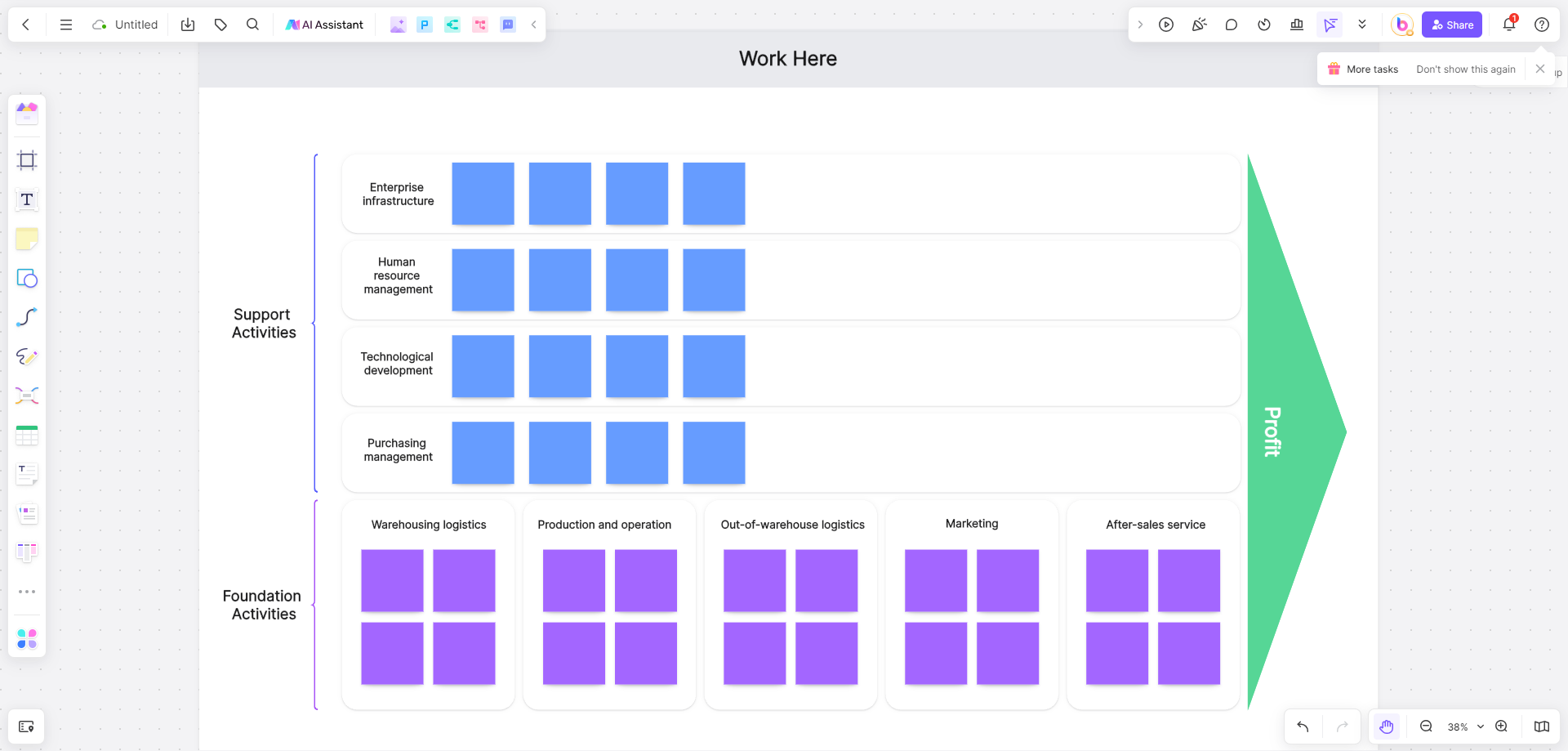
Step 4: Label Each Activity
You can use the text tool in Boardmix to add labels to each box. It's best to be concise yet descriptive in your labels so anyone looking at the diagram can easily understand what each activity represents.
Step 5: Draw Arrows to Show Interconnections
Boardmix has a variety of arrow tools you can use to indicate the flow of activities in your value chain and the interconnections between them. Make sure that these arrows accurately represent the sequence and interactions of activities in your business.
Step 6: Analyze and Optimize Your Value Chain
With your value chain visually represented, you can now analyze how each activity contributes to the overall value of your product or service and look for opportunities for optimization. This may involve changing the sequence of activities, improving efficiency, reducing costs, or other strategies.
And that's it! With Boardmix, you can create a visual representation of your value chain that can aid in business analysis and strategy planning.
How to Use Value Chain Analysis as a Strategic Tool
Value chain analysis can be a powerful strategic tool for businesses looking to identify opportunities for cost reduction, process improvement, and competitive advantage. Here are some steps on how to use value chain analysis strategically.
1. Identify Your Primary and Support Activities
The first step in value chain analysis is identifying your primary and support activities. Primary activities include inbound logistics, operations, outbound logistics, marketing & sales, and service. Support activities include infrastructure, human resource management, technological development, and procurement.
2. Analyze the Value Created by Each Activity
Next, analyze how much value each activity contributes to your product or service. This can involve calculating costs, evaluating efficiency, assessing quality, or considering other metrics that may be relevant to your business.
3. Identify Linkages Between Activities
Understanding the connections or linkages between activities can highlight areas for improvement. For example, there may be efficiencies to be gained by better coordinating inbound logistics with operations or marketing & sales with service.
4. Evaluate Your Competitive Advantage
Assess where your value chain gives you a competitive advantage. This could be in cost leadership (being the lowest-cost producer), differentiation (offering unique products or services), or focus (targeting a specific market segment).
5. Develop Strategies Based on Your Analysis
Based on your analysis, develop strategies that can help you improve performance, reduce costs, enhance value, and strengthen your competitive advantage. This might involve outsourcing certain activities, investing in technology, streamlining processes, training staff, or other strategies.
6. Implement Your Strategies and Monitor Performance
After developing your strategies, implement them and monitor performance to see how they impact your value chain. This may involve tracking key performance indicators (KPIs), soliciting feedback from customers and staff, or regularly reviewing your value chain analysis.
Case Studies: Practical Applications of Value Chain Analysis
In this section, we will delve into real-world applications of value chain analysis. We will examine the cases of three entities – a generic IT company, global coffee retailer Starbucks, and leading dairy producer Ausnutria.
IT Value Chain Analysis
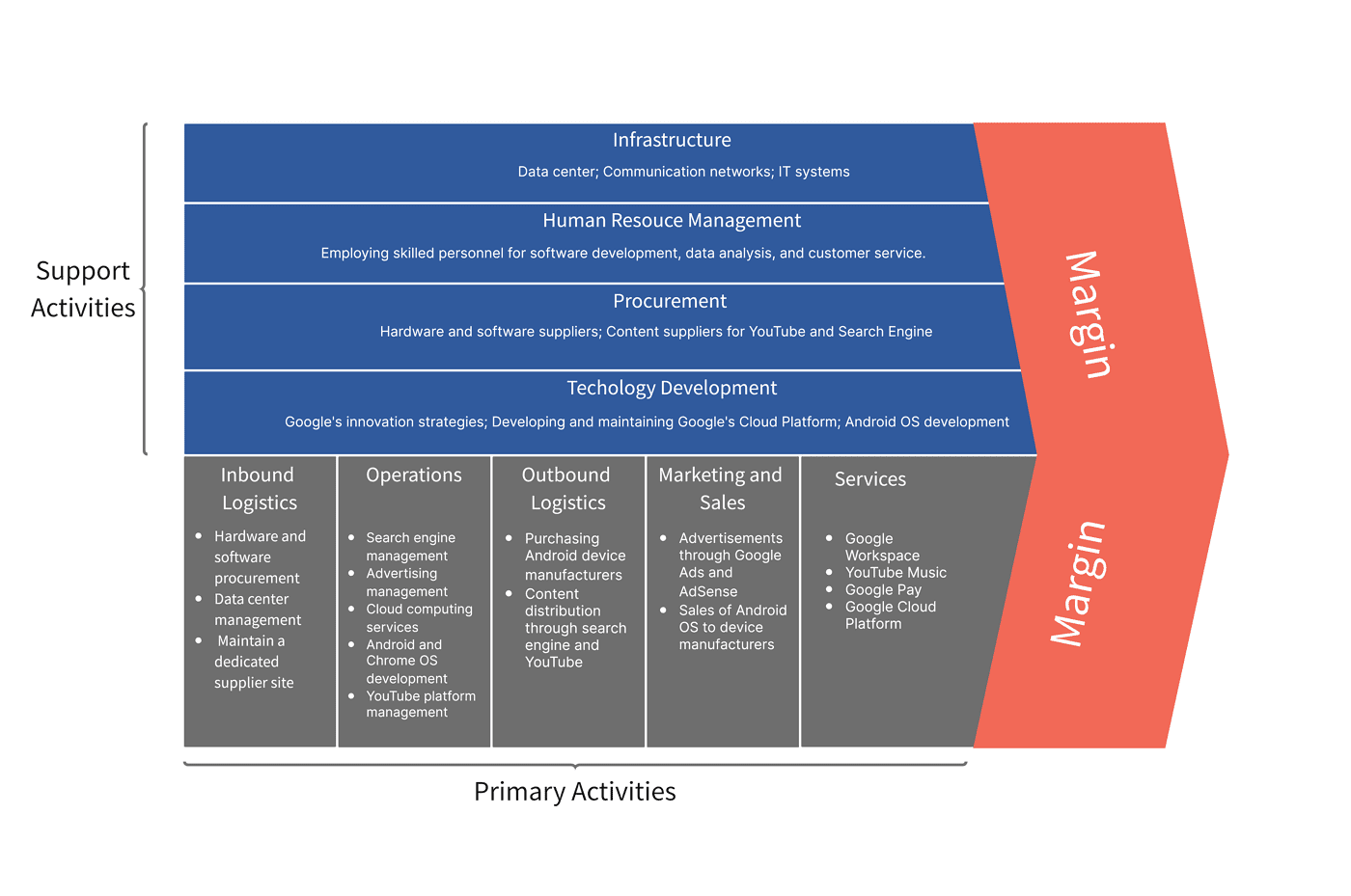
Try Value Chain Analysis for Free
Let's start with a typical Information Technology (IT) company. In an IT value chain, some of the key primary activities include software development, project management, data management, system integration, and customer support.
For example, software development begins with gathering customer requirements and conducting research (inbound logistics), proceeds through designing and coding the product (operations), and ends with testing and launching the product (outbound logistics). Post-launch, the company engages in marketing and sales activities to promote the product and provides ongoing customer support as a service.
On the other hand, support activities for an IT company can include infrastructure (such as servers and software tools), human resource management (such as hiring and training IT professionals), technological development (like research and development for creating cutting-edge solutions), and procurement (of software licenses, for instance).
By analyzing these activities and their interlinkages, an IT company can identify areas where value can be maximized – perhaps through improved project management practices or more effective use of cloud computing resources.
Starbucks Value Chain Analysis
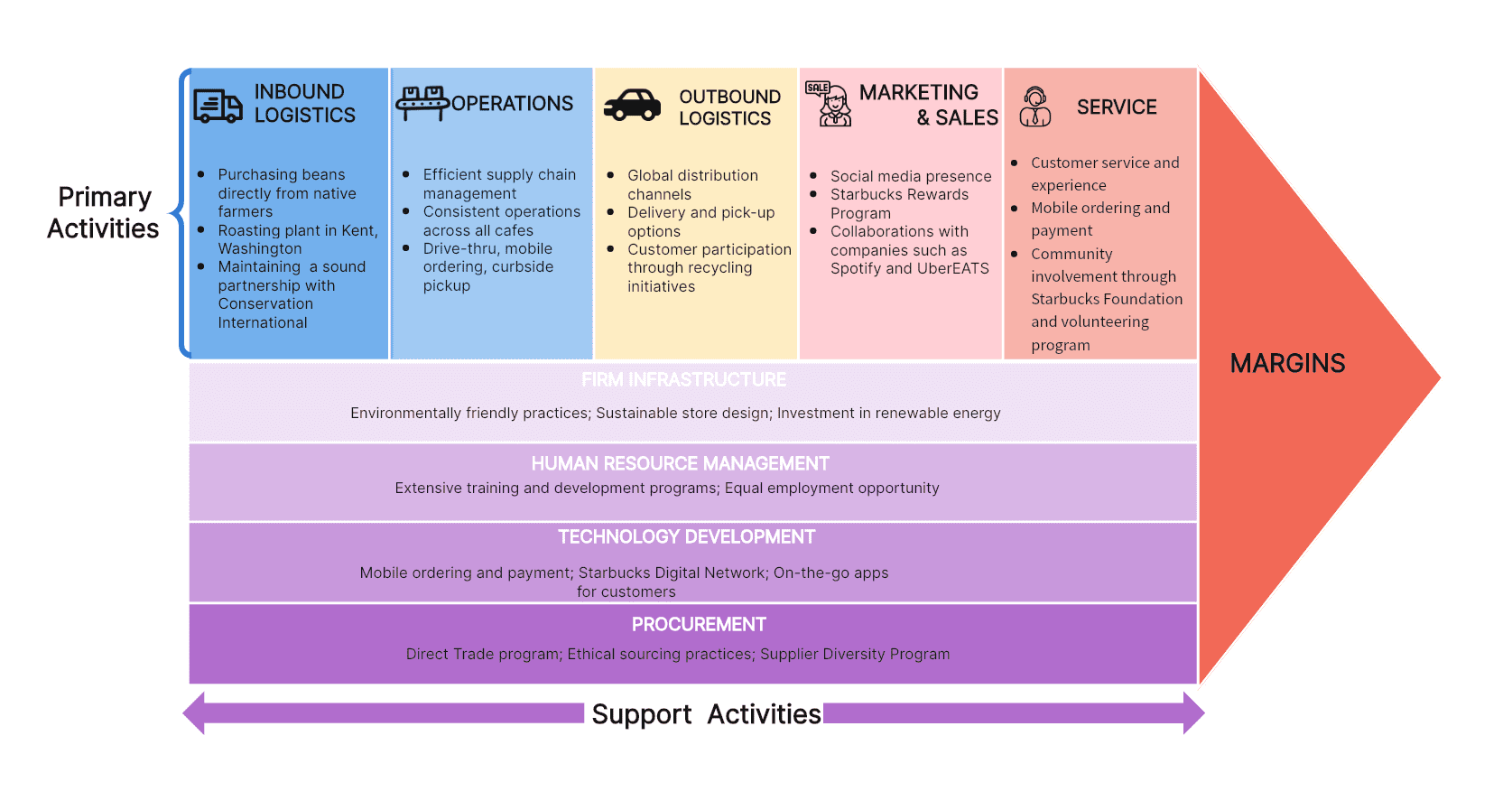
Starbucks Corporation is an example of how value chain analysis can drive business growth in the food and beverages industry.
In Starbucks' value chain, primary activities involve sourcing quality coffee beans (inbound logistics), converting these raw materials into a variety of beverages (operations), and delivering these to customers in stores worldwide (outbound logistics). The company also undertakes extensive marketing efforts to maintain its strong brand image and ensures excellent customer service in all its stores.
Support activities at Starbucks include a worldwide supply chain infrastructure, strategic human resource management that places a premium on employee satisfaction, technological advancements like the Starbucks mobile app, and procurement processes that emphasize ethical sourcing.
The use of value chain analysis allows Starbucks to create a unique customer experience that combines high-quality products with exceptional service. By focusing on areas like ethical sourcing, they also enhance their brand image and create additional value for customers.
Ausnutria Value Chain Analysis
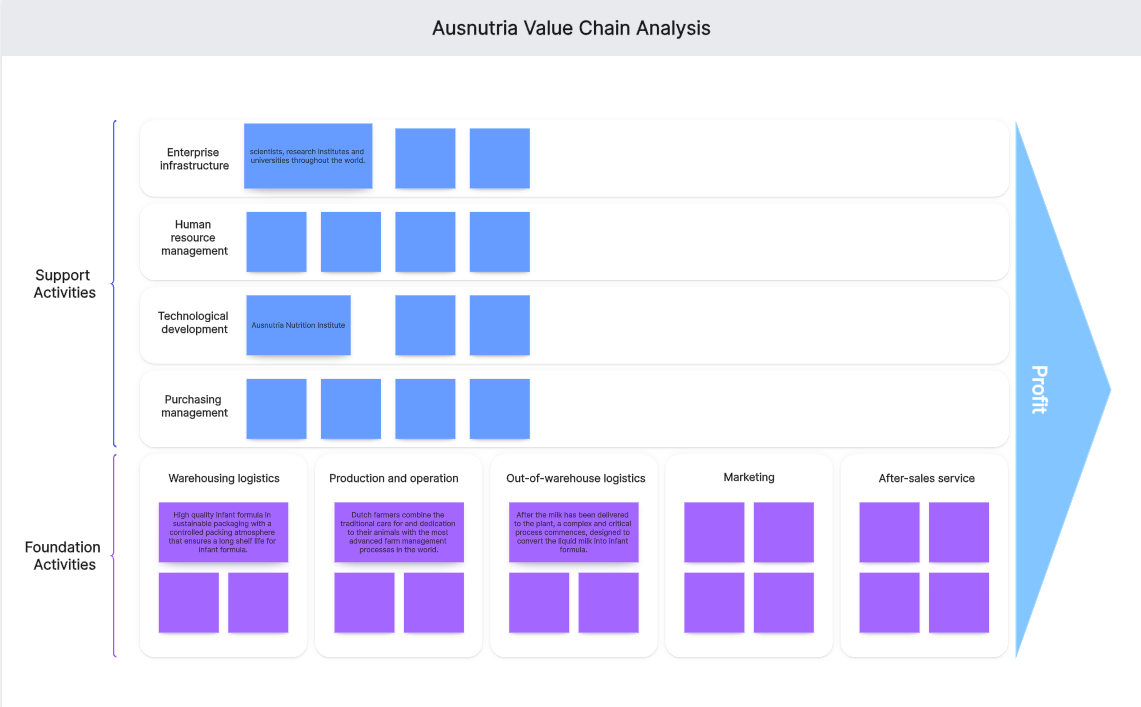
Ausnutria Dairy Corporation Ltd is a globally operating dairy company that focuses on producing infant formula with goat and cow milk.
Ausnutria’s value chain starts from managing its dairy farms for the procurement of quality raw milk (inbound logistics), which is then processed into a wide range of dairy products (operations), and finally distributed to markets across the globe (outbound logistics). Ausnutria also invests significantly in marketing and sales to build brand awareness and provides after-sale services to ensure customer satisfaction.
Support activities in Ausnutria's value chain include an extensive infrastructure ensuring smooth operations from farm to market, human resource management policies emphasizing personnel training and development, technological development for improved processing and quality control, and procurement strategies prioritizing quality and safety.
Through its value chain analysis, Ausnutria ensures it produces high-quality products that meet international standards, enhancing its competitiveness in the global infant formula market.
These cases provide insights into how different organizations across various sectors apply value chain analysis to identify their strengths, uncover opportunities, and consequently, formulate strategies that bolster their competitive advantage.
Next, Let’s explore three different examples of value chain analysis: a marketing value chain, a product value chain, and a customer value chain.
Marketing Value Chain Analysis
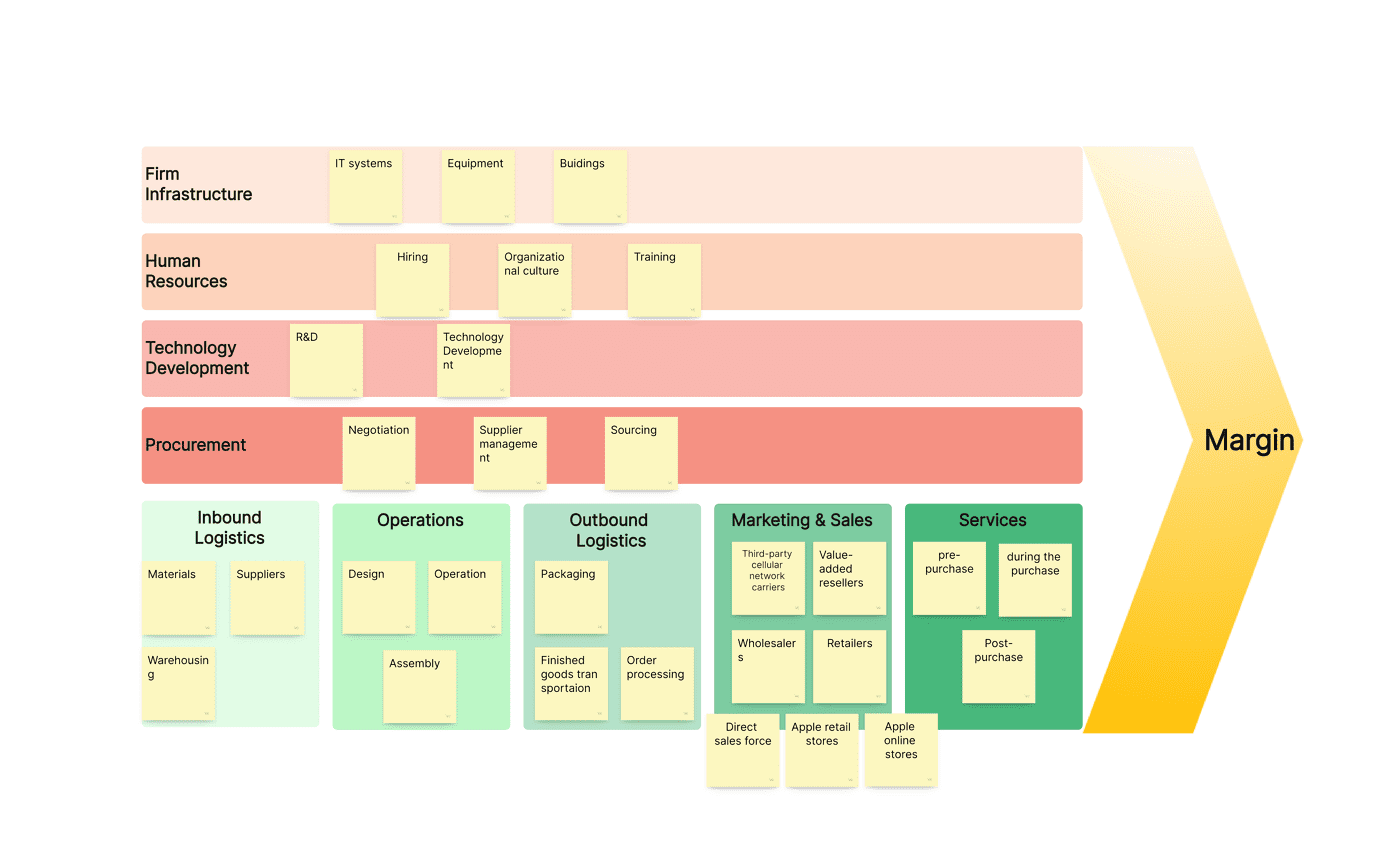
Try Value Chain Analysis for Free
The marketing value chain involves all the activities related to promoting and selling a product or service. These may include:
Market Research: This involves gathering and analyzing data about market trends, consumer behavior, and competitor activities.
Product Development: Based on the market research, a product or service is designed to meet the identified customer needs.
Promotion: Various promotional strategies like advertising, public relations, and social media marketing are used to create awareness about the product.
Sales: The product is sold to the customer through various channels like retail stores, online platforms, or direct sales.
Customer Service: After-sales service is provided to handle any queries, complaints, or issues that the customer may have.
By analyzing this value chain, a business can identify areas of strength and weakness in their marketing efforts and strategize to improve effectiveness and efficiency.
Product Value Chain Analysis
A product value chain refers to all activities involved in the production and distribution of a product. This may include:
Raw Material Sourcing: Procuring the necessary raw materials for production.
Manufacturing: Converting the raw materials into finished products.
Quality Control: Checking the products to ensure they meet set quality standards.
Distribution: Getting the products to retailers or directly to customers.
After-Sales Service: Providing service and support to customers after they purchase the product.
Analyzing a product's value chain can help identify areas for cost reduction, process improvement, and opportunities for differentiation.
Customer Value Chain Analysis
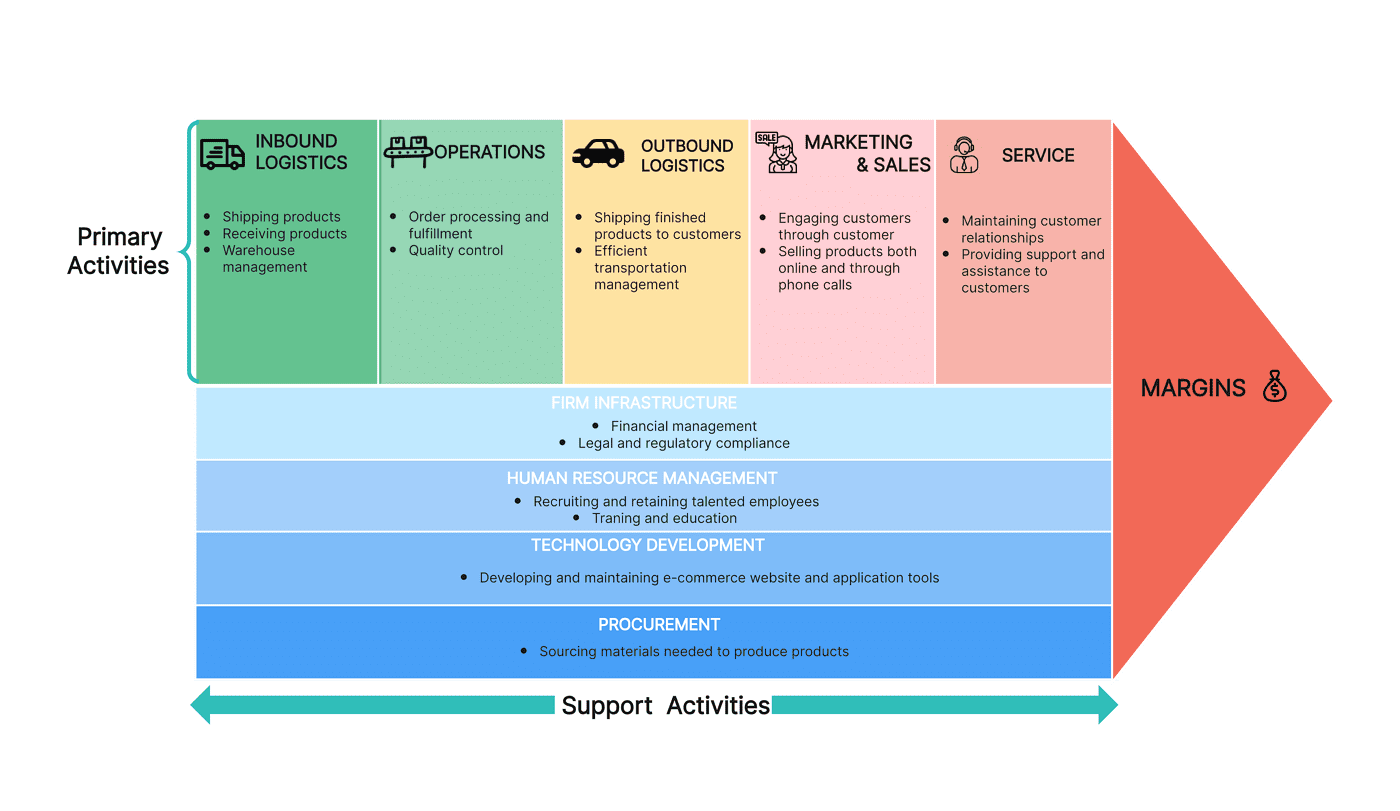
A customer value chain involves all the activities that customers perform while interacting with a business. This may include:
Awareness: The customer becomes aware of the business or its products/services.
Interest: The customer develops an interest in the products/services offered by the business.
Evaluation: The customer evaluates the options available to meet their need.
Purchase: The customer buys the product/service.
Use and Service: The customer uses the product/service and interacts with the business for any necessary service or support.
A business can use customer value chain analysis to understand its customers' experience better, identify their needs and pain points, and improve overall satisfaction.
Each type of value chain analysis offers unique insights that can help a business improve its operations, strategy, and customer relationships. However, it is important to note that these analyses are interconnected and influence each other. For example, a well-executed marketing value chain can improve the customer value chain by increasing awareness and interest. Therefore, businesses should consider all relevant types of value chain analysis for a holistic view of their operations.
Challenges and Best Practices in Value Chain Analysis
Challenges in Value Chain Analysis
While value chain analysis is an incredibly beneficial tool for any business, it comes with its own set of challenges.
1. Complexity of Analysis
Value chains can be complex, particularly for large organizations that operate in several markets. Capturing all of the different activities and their interactions can be challenging and time-consuming.
2. Lack of Relevant Data
Accurate data is necessary for an effective value chain analysis. However, obtaining this data, especially for support activities like human resources and infrastructure, can be difficult.
3. Rapidly Changing Environment
The rapid pace of change in today's business environment can quickly render a value chain analysis outdated. Keeping the analysis up-to-date requires continual monitoring and updating, which can be resource-intensive.
4. Interdepartmental Collaboration
Value chain analysis requires collaboration from various departments within an organization, which can be difficult if there is internal competition or a lack of coordination.
Best Practices in Value Chain Analysis
Despite these challenges, the following best practices can help businesses conduct a more effective and efficient value chain analysis.
1. Involve Key Stakeholders
Involve key stakeholders from across the organization during the analysis process to ensure that all aspects of the business are considered.
2. Prioritize Activities
Not all activities in your value chain are equally important. Identify those that contribute the most to your competitive advantage and focus your analysis efforts there.
3. Use Standardized Metrics
Using standardized metrics can help you accurately compare your activities to industry benchmarks and competitors.
4. Continuously Update Your Analysis
Because business environments are continually changing, regularly update your value chain analysis to ensure it remains relevant.
Future Trends and Innovations in Value Chain Analysis
Looking forward, several trends and innovations are likely to impact how businesses conduct value chain analysis.
1. Increased Use of Technology
Technological innovations like big data analytics and artificial intelligence can provide businesses with more detailed and accurate insights into their value chains. These technologies can help businesses identify inefficiencies and opportunities that they may not have recognized otherwise.
2. Sustainability and Social Impact
With increased consumer awareness around sustainability and social issues, businesses will need to consider these factors in their value chain analysis. This could involve analyzing the environmental impact of their activities or examining how they impact local communities.
3. Globalization and International Value Chains
As businesses increasingly operate on a global scale, understanding international value chains will become increasingly important. This could involve analyzing how activities in different countries contribute to a company's overall value proposition.
4. Industry 4.0 and the Digital Value Chain
The fourth industrial revolution (Industry 4.0) brings with it a new focus on digital value chains. This involves analyzing how digital technologies like cloud computing, the Internet of Things (IoT), and blockchain can enhance the value-creation process.
Adapting to these future trends will enable businesses to keep their value chain analysis relevant and effective, allowing them to continue to use it as a tool for gaining a competitive edge.
The Bottom Line
As an online diagram maker for Value Chain diagrams, Boardmix streamlines data collection by easily importing and collating data from various sources, saving time and effort. The software’s powerful visualization tools help users map the entire value chain, making relationships between activities clear.
Also, Boardmix offers ready-made free value chain analysis templates, enhancing efficiency. Its collaboration features facilitate input from multiple departments, fostering teamwork and collective decision-making. Additionally, Boardmix supports continuous monitoring and updating of the value chain, ensuring insights remain relevant and accurate. Try and create your Value Chain Analysis for free now!








